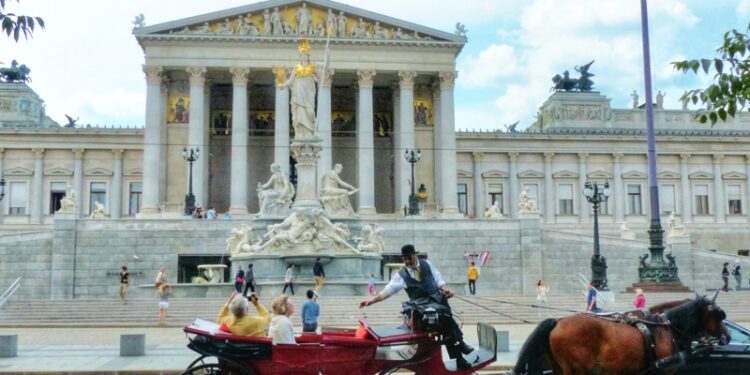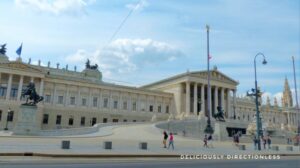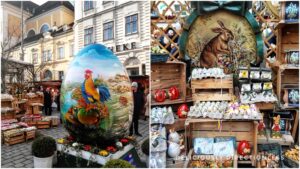
Planning a trip to Vienna this year? The elegant Austrian capital is consistently rated as one of the top places to live in. I can spend days wandering about the city, dipping in and out of palaces and museums. Or spending hours writing and sipping coffee in one of the many coffeehouses. Or just hanging out in the city’s many parks. But if you have limited time, here’s my guide to Vienna to help you make the most of the city.

King’s Men

Imperial Vienna was the seat of the powerful Hapsburg Empire that ruled over most of central Europe for nearly seven centuries. The city has many palaces and royal buildings, the most important of which is the Hofburg or the Imperial Palace. Pop inside to see how royalty lived – the rooms and banquet halls are sumptuous, the furnishings opulent, and the artefacts priceless. The Sisi Museum is dedicated to Empress Elisabeth, queen to Emperor Franz Joseph. At the Spanish Riding School next door, you can watch gorgeous white stallions perform the famous Lipizzaner ballet.

The palace is located on Ringstrasse, Vienna’s elegant ring road boulevard. It has many monumental buildings such as the Parliament, the City Hall, several museums, and the striking Vienna State Opera.
Schönbrunn Palace, 8km outside of Vienna, is the most impressive of all royal buildings. The massive baroque complex was the royal summer palace and is appropriately lavish. The extensive grounds house several parks, a palm house, and even a zoo.

Obviously, do not miss St Stephen’s Cathedral, a veritable symbol of the city with its gorgeous colourfil tiled roof.
Art House

With more than 100 museums, Vienna is an art lover’s delight. The Kunsthistorisches Museum (Art History Museum) is perhaps the most important, housing the massive Hapsburg collection. You can find several of the masters in there – everyone from Raphael and Rembrandt to Titian and Vermeer.

The baroque Belvedere Palace also houses several collections, the most important of which are Gustav Klimt’s famous golden paintings, The Kiss and Judith.

One of the most exciting art destinations in Vienna is MuseumsQuartier, near the Imperial Palace. There are several museums here, including the Museum of Modern Art and the small but significant Leopold Museum. The complex has many restaurants, cafes and bars, making it a very lively place to hang out in the evenings.
On Your Plate

You will eat well in Vienna, whether it’s at a fancy restaurant or at a traditional Beisl, the Viennese version of the cosy English pub. The rustic Griechenbeisl (Fleischmarkt 11) is the oldest restaurant in Vienna, dating back to 1447. Try the local specialties like Wiener schnitzel or the goulash.
Burggarten houses the former royal greenhouse, which is now a trendy café-brasserie, Palmenhaus (Burggarten 1). The atmosphere is almost tropical with lots of trees inside; I recommend the local grilled fish.

Another Viennese institution is Trzesniewski (Dorotheergasse 1), which is always full of locals who come by for a pfiff (0.175L) of beer. Pair it with open sandwiches with a mind-boggling number of toppings — try the sweet & spicy peppers or anything with herring in it. For a more comprehensive guide to Vienna and its many culinary delights, read this blog post.
Wine Trail

© WienTourismus/Mafalda Rakoš
Coffee Time

No guide to Vienna can be complete without talking about its coffeehouse culture. The city has many historic cafes that are meant for lingering in (and for people-watching). The grand Café Central (Herrengasse 14) was a meeting point of artists and intellectuals, and it retains its pre-War charms.

Café Sperl (Gumpendorferstrasse 11), with its intimate booths and quaint ambience, invites you to savour their chocolate-almond house cake, Sperl Torte. Drop by at Café Frauenhuber (Himmelpfortgasse 6), one of Vienna’s oldest cafés where both Mozart & Beethoven have performed. On my latest trip, I discovered another cafe — not a historic one, but great coffee nevertheless! Drop in at CaffèCouture located in the passage of Palais Ferstel in Freyung. You can find a more detailed guide to Vienna and its coffeehouses here.
Festive Cheer

Twice a year Vienna hosts spectacular festive markets. For two to three weeks before Easter, you can buy beautifully decorated Easter eggs, as well as traditional decorations and handicrafts at the Easter markets in the city. The Schönbrunn Palace hosts the largest Easter market where kids can participate in Easter nest hunts and Easter Bunny workshops.
The pretty medieval square Freyung builds the biggest tower of eggs in the city — this year there was a giant, revolving Easter egg painted with a rooster and some bucolic scenes. You can also partake of traditional dishes at these markets, including the roast Easter lamb. On Easter Sunday the Prater hosts a colourful party, complete with live music acts, arts and crafts workshops, games, and children’s puppet theatres.

Come November, the city lights up again with several Christmas markets, with both Schönbrunn Palace and Freyung hosting numerous stalls selling local delicacies. But the biggest market is in front of the City Hall in Rathausplatz, which puts up the tallest Christmas tree in Vienna. Sip on some gluhwein, take a bite of a bratwurst or kasekrainer (cheese-stuffed sausage), and load up on the lebkuchen (gingerbread biscuits). Hand-painted glass balls and colourful knitted gloves are wonderful souvenirs or gifts. Read more about Vienna’s Christmas markets here.
Turkish Airlines has frequent flights to Vienna with a layover in Istanbul. If you can manage an upgrade to business class, there’s nothing like flying high with Turkish Airlines! Read about my business class experience with Turkish Airlines here.
Where to Stay in Vienna

Hotel Sacher (Philharmonikerstrasse 4) stands right opposite the Vienna State Opera and practically oozes old-world charm. Hotel Sacher is part of the Leading Hotels of the World consortium, so you can expect a certain standard of accommodation & service. I absolutely loved my Nussknacker Suite, which was bathed in gold and had a regal air about it. With gilded wallpaper, dull gold upholstery, massive chandeliers, and fresh tulips this is probably the fanciest hotel room I had stayed in! Not to mention the huge bathroom with a bathtub and ample wardrobe space. For other stay options in Vienna, read this post.
I hope this guide to Vienna has been useful. Have you been to the Austrian capital? What are your favourite things to see and do? Leave me a comment below.

Disclosure – This trip to Vienna was made possible by Turkish Airlines and Leading Hotels of the World. However, the blog post contains collated wisdom from three trips to the city.



I've taken notes, specially of the wine trail 😀
Cheers! Take me along as your guide 😉
Bookmarked for the future. Too bad I had to cancel my trip following in your heels this summer :-/
Yes, that was a shame. But another chance will come up I'm sure 🙂 Try coinciding your trip with one of the festivals; Vienna really pulls out all stops then